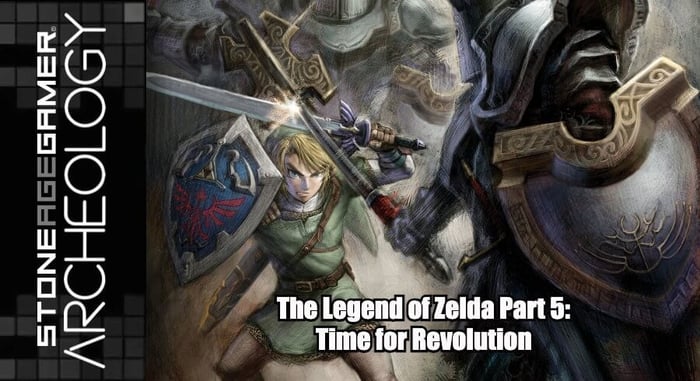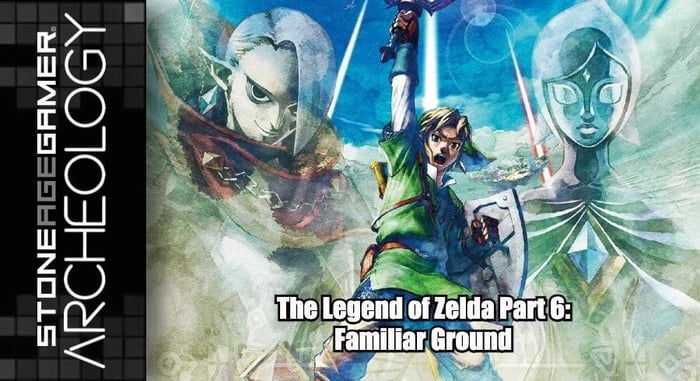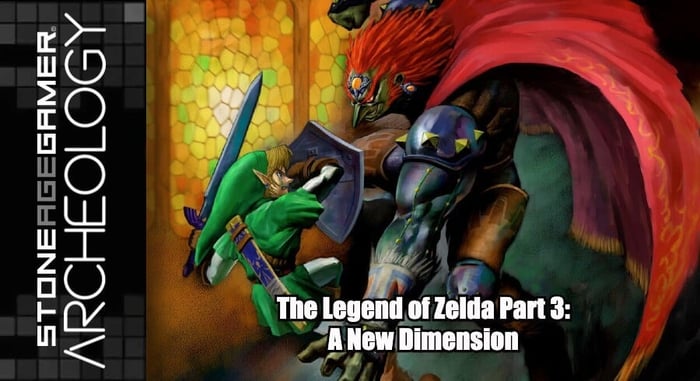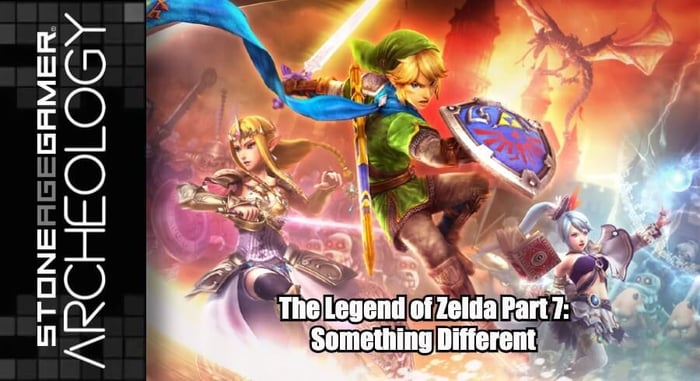
The Legend of Zelda Retrospective Part 5 - Time For Revolution
Welcome to Part of our 8-part Zelda retrospective. In this episode, we cover Nintendo's delivery of their first true fan-service fueled Zelda game, Link's first forays into touchscreen gaming, and some of the most unusual releases the franchise has ever seen.
In this series, we aim to tell the story of the Zelda series as it unfolded for North American audiences. We are not only looking at the games themselves, but the historical context surrounding them, and what it was like being a fan as these games were being released.
Watch more Stone Age Gamer Archeology: https://youtube.com/playlist?list=PLoWJAVdwC7Z_CC...
Transcript of the video:
As the battle between the PlayStation 2, Xbox, and GameCube raged on, Nintendo’s platform was once again falling behind. Even with titles like Eternal Darkness and the Resident Evil remake, Nintendo couldn’t shake their “for kids” image. 3rd party support was better than it was during the Nintendo 64 era, but thanks to the GameCube’s proprietary mini disc format, it still lagged far behind the competition in terms of both quantity and quality. As for The Legend of Zelda, The Wind Waker reviewed well, but fans had still not gotten over the more realistic tech demo from Spaceworld 2000. Mainstream gaming tastes in the US remained all about grit and realism, and no amount of quality Nintendo could muster was going to change that.
But Nintendo had a plan, and they unveiled it to the world at E3 2004.
Future CEO and President of Nintendo of America, Reggie Fils-Amie made his on stage debut, and immediately followed his opening statement with an onslaught of trailers that aimed to back up their slogan for the year “we make games that make games worth playing.” Metroid Prime 2 and StarFox Assault kicked off the presentation, which led into the jaw-dropping show stopper that was the Gamecube exclusive Resident Evil 4. Advance Wars, Pokemon, Paper Mario, Pikmin, F-Zero, Nintendo had something for everyone. But that wasn’t all. Beyond a brazen confidence in their sales data and aggressive new marketing plans, as well as the promise of being able to play these new titles on the show floor once their presentation concluded, Nintendo also unveiled their new touchscreen handheld device, the Nintendo DS. It was Nintendo firing on all cylinders, and both fans and the gaming press couldn’t help but be blown away by the massive turnaround in quality content. Still, Nintendo was determined to hold nothing back, and they weren’t done with the audience yet. But not even Nintendo could have predicted the reaction to what they were about to do. Reggie took the stage once more, and made history.
The applause was deafening as series creator Shigeru Miyamoto took to the stage with Master Sword in hand to explain that it was finally time for Link to grow up. It was one of the most exciting moments in the history of the Electronic Entertainment Expo, and Nintendo fans couldn’t have been happier. Unfortunately, the excitement didn’t last.
Metroid Prime 2 had the misfortune of launching against Microsoft’s unstoppable juggernaut Halo 2. Star Fox Assault disappointed fans and critics alike. Resident Evil 4 was no longer a GameCube exclusive, and The Legend of Zelda would be delayed for another two years.
The GameCube was ultimately unable to regain ground in North America, and while by no means an abject failure, it simply couldn’t compete with Microsoft and Sony on their terms. If Nintendo was going to be successful in the home console market, they would need to change the game yet again. It was time for a revolution.
The Nintendo DS had quickly become a surprising success. Its unconventional display and touch screen were exciting for players and developers alike, and helped Nintendo reach a new expanded audience like never before. Casual gamers were flocking to the DS, and Nintendo wanted to bring that excitement to their home console line with the GameCube’s successor, the Nintendo Revolution. Its initial reveal at E3 2005 was cryptic, especially in terms of what would eventually make the system every bit the revolution its name promised. A few months later at the 2005 Tokyo Game Show, Nintendo unveiled their new console’s secret weapon, its revolutionary new controller concept, and players finally began to wrap their heads around what Nintendo had officially dubbed Wii. Its unique controller would bring motion gaming to the masses, and Nintendo ensured its success with games that would appeal to everyone. For the casual market, the system came packed in with Wii Sports, a game that would go on to become a bonafide global phenomenon. For the core gamers, they had The Legend of Zelda, which would now serve as both premiere launch title for the Wii, and swan song for the GameCube.
The Legend of Zelda: Twilight Princess released alongside the Nintendo Wii on November 19, 2006, and now fully incorporated motion controls. Players would have to swing the Wii Remote to make Link use his sword, and other items like the boomerang and arrows would be aimed using the IR sensor. In an effort to make this feel more natural, Nintendo decided to make Link right handed like the majority of the population, but rather than recode the entire game, they simply reversed it, making the Wii game a literal mirror image of its original GameCube incarnation. It featured a more muted color palette than any previous Zelda game, with realistic art direction to match, and at no point were players tasked with controlling Link as a child.
This time around, Link was a farmhand in Ordon Village. One day, monsters attacked and kidnapped the local children. Link attempted to rescue them, but ran into an ominous dark veil looming over the area. A hand reached out and pulled him in, where he was somehow transformed into a wolf, captured, and imprisoned. While locked away, Link came in contact with a mysterious creature named Midna who freed him in exchange for his service. The two made their way to the top of Hyrule Castle where they met Princess Zelda, who informed Link that a sorcerer named Zant had invaded Hyrule and taken the castle by force. He hailed from an alternate dimension called The Twilight Realm, where he had usurped the former ruler and crowned himself king. Much like the Dark World from A Link to the Past, The Twilight Realm functioned as a secondary map that Link couldn’t traverse as his original self without the use of a special item. In lieu of the Moon Pearl, this time Link would need to find the Master Sword to retain his form, in addition to a series of relics called Fused Shadows that Midna required to gain enough power to destroy Zant. Once the Master Sword was obtained, players gained the ability to transform to and from Link’s wolf form at will, an ability that was indispensable in traversing this new massive Hyrule. The map was one of the largest the Zelda series had ever seen, but there was a catch. For as much real estate as the game boasted, most of it was barren.
Unlike previous Zelda games, Twilight Princess was created as a direct response to what fans claimed they wanted. As a result, the game often seemed at odds with itself, and was criticized for feeling uninspired. There were enormous open areas suited for horseback battles, but once cleared, they left large portions of the map devoid of any meaningful content. The Wii’s motion controls for aiming were a welcome change, but swinging the Wii remote didn’t actually correlate to how Link swung his sword, effectively merely replacing a button press with a nonspecific gesture. Clever items like the Spinner had very few uses outside the dungeons they were specifically created for, and character models were often grotesque, with exaggerated designs clashing with the realistic aesthetic. Players may have been excited about the idea of a realistic Zelda game, but that realism here conflicted with the very personality that made Zelda what it was. The result was a game that at the time of its release was well liked enough, but for many, was also slightly underwhelming.
At its core, it still retained the same basic concepts introduced in Ocarina of Time, and while it managed to bring forth its own ideas and new takes on existing items, the formula was starting to grow stale, even in terms of story.
Like Vaati and Agahnim before him, Zant was merely a pawn for Gannondorf all along, who once again had ambitions of obtaining the Triforce to rule Hyrule. This inevitably led to a multi-phased battle with a possessed Zelda, Ganon’s enormous beast form, a fast-paced pursuit on horseback, and after six years of waiting, a one on one sword fight with Gannondorf, finally making good on the promise of that fabled tech demo. In the end, Gannondorf was defeated and Hyrule was freed. As for the Twilight Princess, that turned out to be Midna, who was able to return to her true form before saying goodbye to Link and Zelda forever, sealing the Twilight Realm off from Hyrule once and for all.
Thanks in large part to its position as a Wii launch title, Twilight Princess was a huge success, quickly outperforming even Ocarina of Time in terms of sales. Though some of its elements were becoming outdated, the game still resonated with certain fans thanks in no small part to its surprisingly quirky personality. The world may have been mostly empty, but it still contained some breathtaking environments. The action set pieces were extremely memorable, and then there was Midna, who proved to be one of the most fascinating and likable characters the franchise had ever seen.
The Legend of Zelda: Twilight Princess released on the Nintendo GameCube one month later in December 2006, and while it lacked the motion aiming and widescreen presentation of its Wii counterpart, many players considered it the superior version thanks to its more traditional control scheme, less cluttered user interface, and of course, Link’s left-handed fighting stance.
For better or worse, Twilight Princess was finally done. Nintendo had given fans the game they wanted, and as usual, the question quickly became “what’s next?” And once again, the answer was completely unexpected.
The Legend of Zelda: Phantom Hourglass released on the Nintendo DS in October 2007, and surprisingly serves as a direct followup not to Twilight Princess, but to The Wind Waker.
Taking place shortly after that game’s finale, Link and Tetra set out to explore the ocean. While at sea, the crew encountered a ghost ship that had been rumored to be terrorizing the seas. Tetrs jumped on board to investigate, but quickly disappeared from sight, and was heard screaming as the ship pulled away. Link tried to jump on board to rescue her, but was unable to maintain his grip and fell into the sea.
He washed up on an unfamiliar island where he was greeted by a fairy named Ciela, who brought him to meet an old man named Oshus. Oshus told Link that he should enlist the help of a boat captain named Linebeck in order to locate the Ghost Ship and save Tetra. They eventually found him in the Temple of the Ocean King where he had gotten himself trapped. Once Link and Ciela helped him out, grabbed a nearby sea chart, and explained their situation, Linebeck reluctantly offered his assistance as long as he got to keep whatever treasure the Ghost Ship held inside. They then set out to find the Spirits of Courage, Wisdom, and Power. Once obtained, they returned to Oshus, and the group tracked down the Ghost Ship only to find that Tetra had been turned to stone by an evil entity known as Bellum, who resides at the bottom of the Temple of the Ocean King.
Once again, players needed to explore the Great Sea, only this time they would have to do it with the use of a touch screen. Every one of Link’s actions, from fighting enemies to even walking around, were performed via touch controls, a system that was divisive among fans, but worked surprisingly well. Everything from controlling your boomerang’s trajectory, to taking notes to help solve puzzles could be done without the use of a single button, making Phantom Hourglass the most accessible Zelda adventure released to date, while also improving on a few of the complaints fans had about The Wind Waker. The ocean was less vast, but it took less time to travel between locations with more interactivity while sailing. Your ship could be upgraded in ways that improved both its cosmetics and usefulness in certain situations. And while ample amounts of rupees were still occasionally required, your default wallet could hold considerably more money, meaning far fewer treasures would need to be left behind.
These innovations were unfortunately counterbalanced by several major issues. The Wind Waker’s visual style wasn’t nearly as effective on the DS, relegating its colorful, expressive world to one that felt considerably less alive. The game’s score largely consisted of short loops that would repeat ad nauseam. But the biggest issue of all revolved around the titular Phantom Hourglass. Throughout the course of the adventure, Link has to repeatedly return to the Temple of the Ocean King, with each visit bringing him closer to the final encounter with Bellum. The Temple worked on a time limit, but every time you returned with more sand in the Hourglass, your progress was reset, meaning by the end of the game players would have to repeat the same dungeon over and over, a process many considered tedious.
Link eventually made his way to Bellum’s lair, but after defeating him and lifting the curse on Tetra, the creature survived and used the Ghost Ship to attack Linebeck’s boat. Following a fierce cannon battle, and Bellum’s temporary possession of Linebeck, the sands from the Phantom Hourglass were returned to the Great Sea, and Link and Tetra found themselves back on their ship to continue their expedition.
While most wouldn’t consider Phantom Hourglass a truly worthy successor to The Wind Waker, it was still a fascinating and welcome return to that world. It simultaneously played strikingly familiar, yet radically different from any previous entry in the series, and was a tremendous success. But Nintendo wasn’t done experimenting with unconventional control styles for The Legend of Zelda, and one month later placed Link in the most unlikely scenario, a shooting game.
Link’s Crossbow Training released for the Wii in November 2007 as a pack in for the new Wii Zapper peripheral. Containing no electronics at all, the Zapper was merely a plastic shell that held the Wii Remote and Nunchuck in a two-handed gun format, designed to make shooting games feel more natural. Defying all logic and reason, it was decided that a Zelda game be made to showcase the Zapper’s capabilities, and the results were interesting to say the least.
Functioning as an expanded shooting gallery, players would move a cursor around the screen to shoot targets that appeared in various locations based on the world of Twilight Princess. Some stages then pulled the camera back to function as a 3rd person shooter where the player would move Link manually with the Wii Nunchuck controller and shoot enemies with the Wii Remote. Critics were undeniably amused by how fun it was to play, but many felt the Zapper itself actually made the experience harder to control, opting to play the game without the peripheral altogether. It was also an incredibly shallow experience offering at most a few hours of gameplay. There was no story to speak of, nor any explanation of how Link came in possession of this fully automatic crossbow, and following a final battle against a Fossil Stallord, the game simply brings you back to the main menu. No ending, no credits, nothing.
Link’s Crossbow Training remains one of the most unusual Zelda games released in North America, but elsewhere in the world, things had gotten even stranger. Prior to the release of Twilight Princess, the first in a series of four Zelda spin offs released overseas for the Nintendo DS, with the final game launching in August 2009. Instead of starring Link or Zelda, the main protagonist was none other than Tingle, and each game was incredibly bizarre. Here in the US though, the Zelda franchise had once again grown disturbingly quiet, and stayed that way for nearly two years. At E3 2009, Nintendo finally confirmed that a new Zelda game was being developed from the ground up for Wii, and it would deliver the one to one sword fighting mechanics that Twilight Princess was missing thanks to the new Wii Motion Plus accessory, but since the game was still early in development, all that was shown was a single piece of concept art. A few months prior though, Nintendo had announced that there was another Zelda coming to the DS, where Link would be utilizing a very different mode of transportation.
The Legend of Zelda: Spirit Tracks released on the Nintendo DS in December 2009, and built directly on what was established in Phantom Hourglass. The game takes place in New Hyrule, which Link and Tetra discovered at the end of their expedition. Now over 100 years later, New Hyrule is a bustling society, as well as home to the series first mass transit system. The spirit tracks and their central station, the Spirit Tower, weren’t just for transportation though. It turns out they also serve as a prison for a Demon King named Malladus who long ago was at war with the ancient spirits.
Upon graduating from Engineering School, A young boy named Link was summoned to the castle by Princess Zelda to help her sneak out and investigate stories of the Spirit Tracks vanishing. On their journey, the Tracks they were riding on disappeared and New Hyrule’s Chancellor Cole revealed himself to be a demon with ambitions of freeing Malladus. Along with a warrior named Byrne, Cole destroyed the Spirit Tower, and separated Zelda’s spirit from her body to steal for use as a vessel for Malladus’s return.
As a spirit, nobody could see Zelda except Link, so the two of them set out together to put a stop to Cole’s plans and return the Spirit Tower, and by extension the Spirit Tracks, to normal.
For the first time, Link and Zelda now had to work side by side for the entire adventure. Link has his usual repertoire of attacks and items, but Zelda has the newfound ability to possess mystical guards called Phantoms. This allowed her to help in both combat and puzzle situations throughout the game.
Exploring New Hyrule was a vastly different experience from the Great Sea since Link was relegated to traveling exclusively via the Spirit Tracks. There were still numerous places to go, and traversal itself was more active and engaging than ever thanks to having to follow the rules and regulations of the established rail system, but the sense of exploration was diminished greatly by the overworld becoming quite literally an on-rails experience.
Many aspects of Phantom Hourglass were improved on though, including more expressive characters, more varied music, and a less tedious central dungeon. New items utilized the DS system’s various functions in unique ways, like the Spirit Pipes which could be played by blowing into the system’s built-in microphone, a callback to the original Legend of Zelda on the Famicom Disk System.
Eventually, Link and Zelda would face off against Cole on the back of a demonic train, where Malladus had successfully possessed Zelda’s body. Once defeated, Zelda was still unable to reinhabit herself. With some help from a surprise ally, she eventually succeeded, but at a cost. With no other options available to him, Malladus devoured Cole, but the two were incompatible and Malladus began to die. With what little time he had left, he decided to try and inflict as much damage on the world as he could, leaving Link and Zelda to team up once more to destroy the beast for good.
Spirit Tracks was lauded for its improvements over Phantom Hourglass, but for all its critical acclaim, its sales fell well short of its predecessor. Following its release, the series would enter yet another drought period without a single new installment or news for almost two years. But if Zelda fans had learned one thing, it was patience, and as luck would have it, Nintendo had some very ambitious designs in store.
Join us next time as Nintendo tells the earliest story in the series timeline, and begins laying the foundation for the franchises most significant shakeup yet.





